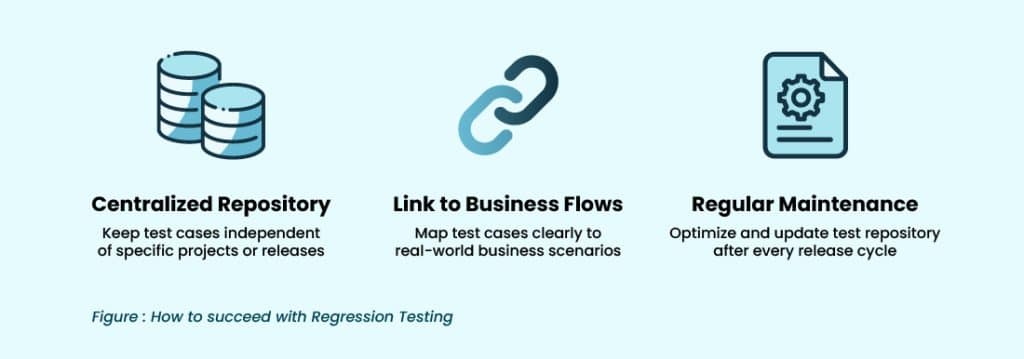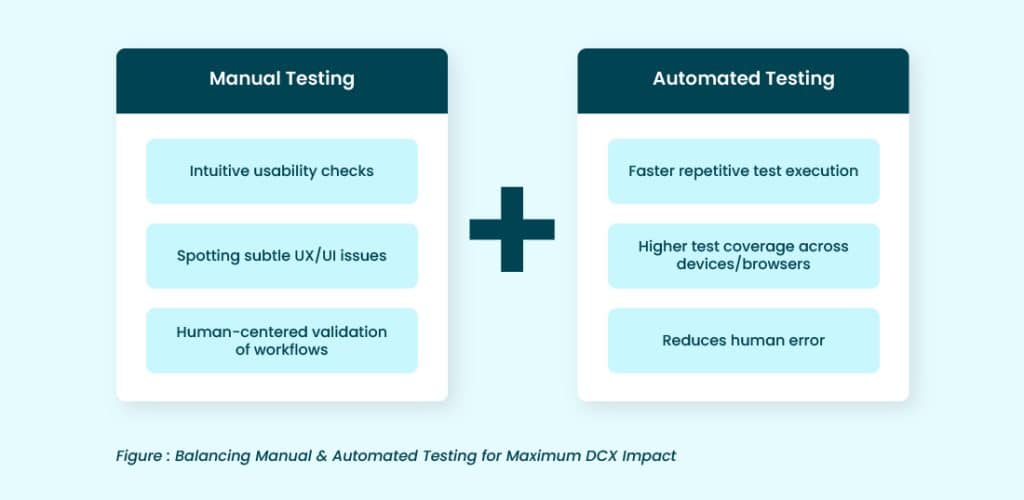Picture this: You’re in the final step of checkout, excited to complete your purchase, but suddenly the “Pay Now” button doesn’t work. Frustrated, you abandon the site and move on to a competitor.
Sound familiar? You’re not alone, 88% of customers won’t return after a bad digital experience. The real question is: How can businesses prevent these losses before they happen?”
The end customers are increasingly loyal to the products and services that consistently provide maximum value with the least friction. However, Digital Customer Experience (DCX) is not only concerned with the customers. Employees depend on multiple internal digital platforms to perform their tasks efficiently.
When the systems take time, fail to respond, or are complex to operate, it is the major cause of frustration, low adoption, and productivity level drops. If the employees have a hard time with their digital apps or websites, they cannot give their customers the best experience either.
The trick is, how can companies prevent these costly digital roadblocks? The answer is that comprehensive testing strategies are the ones that find and eliminate issues prior to users facing them. The test engineers could ensure the flawless operation of every interaction if they check all the functions (navigation, sign-ups, payments, and third-party integrations) before the release date of the applications.
An ideal DCX is characterized by reducing churn, increasing trust, and in the end, keeping the customers and employees satisfied and involved.
Guarding Core Features and Business Rules
To succeed, every business must build a strong digital customer experience. Companies that gain a competitive edge are those that invest in and adopt digital testing practices. Functional testing can ensure a flawless digital experience for not only clients who purchase products/services but also employees who oversee daily operations.
Indeed, because 90% of companies are now undergoing some form of digital transformation (McKinsey & Company, 2024), businesses are not able to tolerate glitches, broken workflows, or complex integrations that may disrupt the customer journey. Every single interaction has to be seamless regardless of the device or platform that is in use; be it a purchase, a search, or a form submission.
Digital Customer Experience testing ensures that every core feature—logins, form, and integration works exactly as intended, providing a seamless experience to users. It provides the user with the feeling of proactivity virtual flows that include, among others, product searches and checkouts with an error-free smooth navigation.
Furthermore, it ensures the patterns to be as expected such as discount logic or multi-step approvals to be in place so that well-formed workflows and error handling can be executed. By establishing test cases from requirements and user stories and, through the utilization of advanced testing techniques, functional testing stands as a shield to a reliable and intuitive digital experience.
Omnichannel Testing for Consistent User Journeys
Have you ever started a task on your phone, continued it on your tablet, and then ended your task on your laptop? Nowadays, multiple gadgets are used by customers to switch between tasks, so companies must ensure ease of use on every device. This is exactly what cross-platform testing is about: it determines whether apps and websites are compatible with different screen sizes, operating systems, and hardware configurations.
Today, as we are switching from smartphones to tablets and laptops, engineers are required to assure the smoothness of every shift. For example, cross-platform testing helps us to determine the efficient working of applications and websites on a variety of screen sizes, operating systems, and hardware setups.
You could buy a range of physical devices for testing which is a costly affair, or you could use a cloud-based platform like Pcloudy to test on multiple real devices. In the end, validating workflows on every possible setup ensures a frustration-free experience that keeps users happy wherever they are.
Ensuring Seamless Digital Workflows with End-to-End Testing
End-to-end testing is very crucial to ensure that your digital application integrates well with internal systems and services provided by third parties. The validation of the interaction of these integrated systems with more complex workflows ensures that vital processes with many touchpoints, such as APIs and external vendors, are running smoothly.
A testing team should carry out the prioritization of testing efforts by carrying out a business risk analysis through the calculation of the impact and likelihood of failure in each business workflow.
By substituting workflows and checking everyday scenarios, the mapping of workflows and, companies can confirm the easy work at all touchpoints. Keep in mind that if individual features work properly, an unfixed workflow can still ruin the user experience. Creation of detailed test cases is done by looking at workflow diagrams and end-to-end business process maps, which in turn assure consistent data flow and stable functionality.
Most importantly, remember to check in all the browsers and on all different devices and browsers, so that the users can complete all the steps smoothly, no matter how they access an application like yours.
Regression Testing: The Backbone of Reliable Releases

To make you think of a case, on the implementation of a new release, the checkout feature on the e-commerce website may not function, while it has not been updated. Such as in the case of users, who are used to this feature being stable, it creates the biggest dissatisfaction.
It is essential that the existing functionalities operate as expected after the application is updated and the bugs are fixed. To achieve this the team developing regression testing to be successful should: –
- Have a centralized repository for regression test cases which is not connected with a specific project or release.
- Link the test cases to business process flows for the setting of them according to real-world scenarios.
- At least once after every release, it is necessary to maintain and optimize the repository to have a proper and efficient tool.
A powerful regression testing approach is the foundation of successful software releases, eliminating stumbling blocks in the core features.
Inclusive Digital Customer Experience and Driving Consistency
Applications that are user-friendly and inclusive to the customer are the key things to take care of in our digital world. I wonder if you know that nearly 1.3 billion people, that is, 16% of the world’s population, are differently abled. This is why WCAG 2.2 compliance serves the function of ensuring that the availability of the apps is always on and includes not only blind Users with no sight at all, but other users like hard of hearing and other disabilities.
To begin with, it’s important to mention the fact many services now are digital-only, therefore, the priority should be to design applications that are friendly to everyone in spite of any disabilities that may exist. Usability testing of web pages is the basic element of accessibility for all the users with different disabilities. It allows differently abled users to use the features and navigate through a website or an application without any kind of problem.
The Pcloudy platform provides accessibility testing features that can provide detailed reports that document the problem, its location, source, and impact by validating your application against WCAG standards.
A customer shopping on an e-commerce site visits the ecommerce store where they want to buy a shirt however, the “Add to Cart” button does not display. They abandon the idea and move on. However, the analysis indicated that the button was hidden by a text box because of a mobile device’s space constraints. This issue went undetected during functional testing, but visual testing could have caught it instantly.
Visual testing can bring out design shifts, rendering issues, or layout inconsistencies across various browsers and devices. Using the Visual AI capabilities of platforms like Pcloudy, one can overcome the limitations of traditional usability testing and reduce the manual testing effort, thus ensuring a consistent design across various real browsers and devices.
Striking the Perfect Balance between Automated and Manual Testing

Think of yourself being responsible for the testing for a new e-commerce site release that overhauls its checkout process, and you will need to guarantee that everything is running without a hitch on all devices. Using a combination of automated and manual testing is very important in this case: automation can execute repetitive tests and the different kinds of tests: functional, regression, end-to-end, compatibility, usability, accessibility tests.
For example, automated tests can quickly verify that every button, form, and integration work correctly across various browsers and devices, saving a lot of time. When it comes to minor details in the interface—like the sense of ease of a checkout flow—testing techniques like exploratory testing proves to be crucial as it is necessary to have user intuition that may help machines to see but can’t.
With many digital transformation projects always coming up with updates every week or month, the usage of automation has reassuringly reduced the cycle time. Tools such as the self-healing AI Agent by Pcloudy dynamically change and can automatically adjust to the modifications in the UI, thus the resources needed in terms of automated test maintenance are also cut down.
As a result of using the cloud to connect tests that are running in parallel on diverse devices and browsers, one can be certain that updates will be released smoothly and that the end-users will have a hassle-free digital interaction.
Conclusion
A digital customer experience is a crucial aspect of boosting the happiness among users and the productivity of employees. One must ensure all the interactions are smooth and the system is running fine by carrying out such tests- from functional, usability, end-to-end to regression and accessibility checks.
The perfect balance of automatic and manual testing techniques guarantees that we are able to identify the issues faster – in many cases, even before a real user faces them. In the end, the powerful testing strategies will help to serve a digital experience that’s inclusive, engaging, and totally hassle-free.






